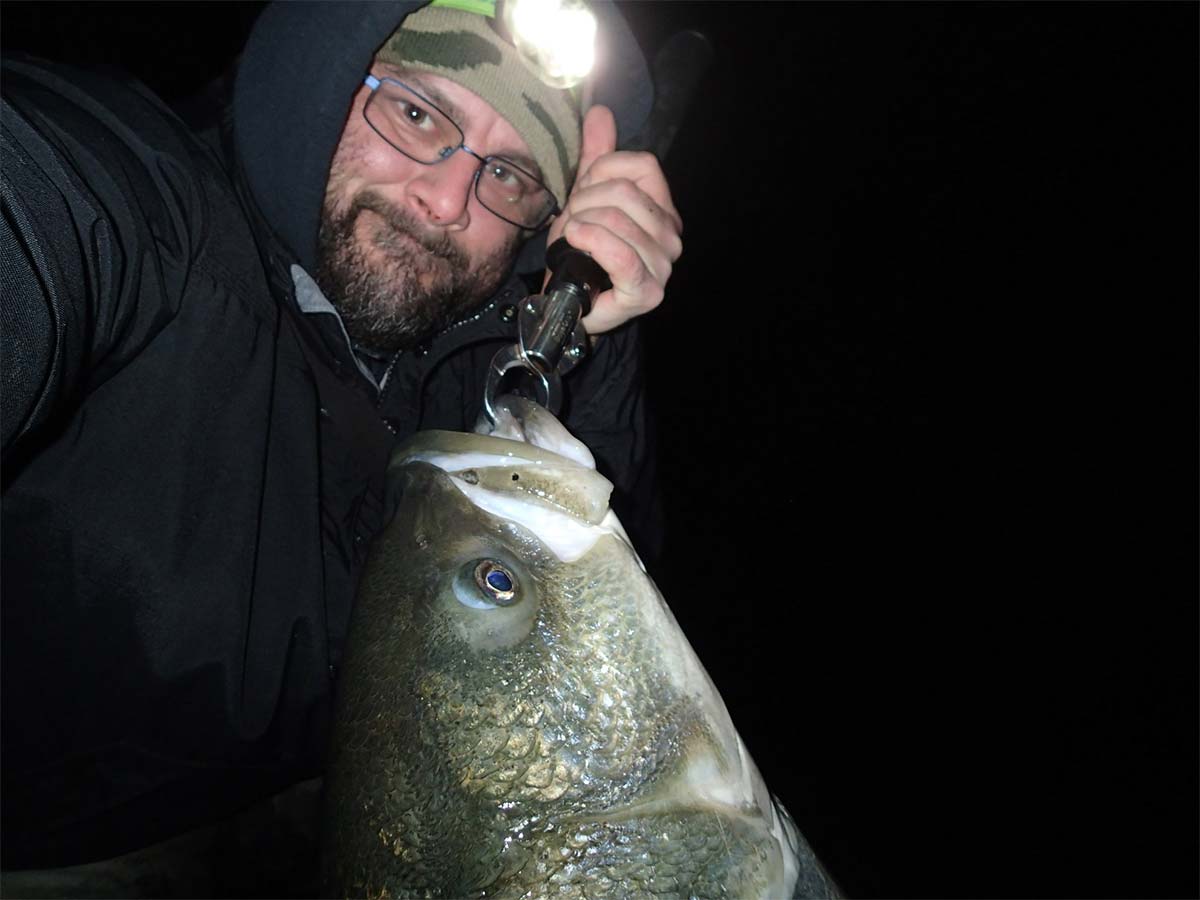
Appreciating the senses of your target species will help in anticipating their behavior.
Do striped bass have the same senses as humans? Surely not since both are accommodated to drastically different environments, right? Taking the time to understand the striper’s sense differences and similarities to that of humans, can also allow us to increase our catch.
Our taste and smell senses do have some overlap. There’s a trick to experience how much our taste relies upon our smell. Next time you go to taste something, attempt it both, while pinching and not pinching your nose. Striped bass also have overlap, but with caveats. They have two pairs of nostrils (nares), and more sensitive olfactory tissue.
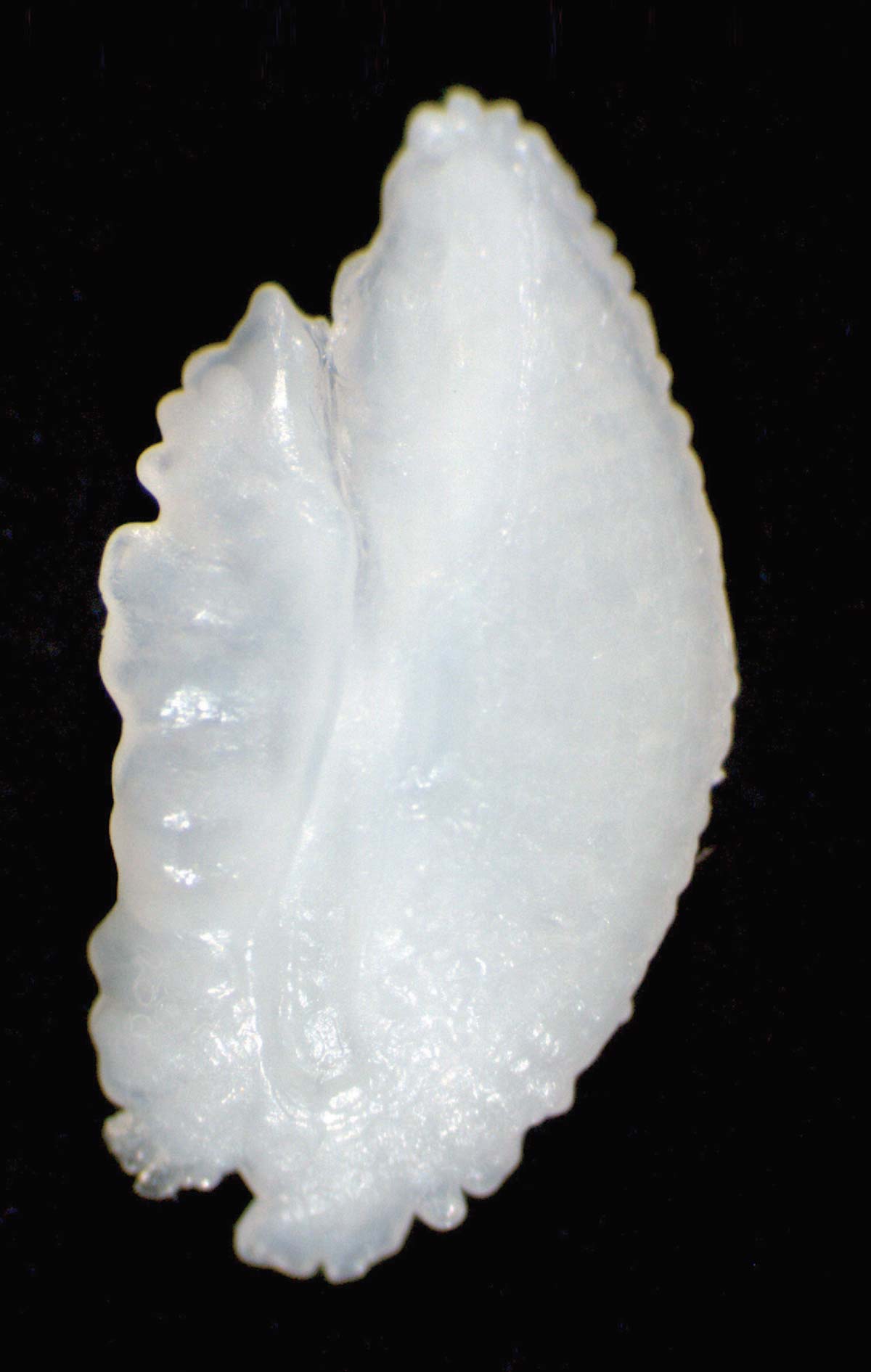
Striped bass also have taste buds not just on their tongue, but on all their mouth and outer lips. How is this important to an angler? Well, it could explain certain instances when a sluggish bass lips your plug lightly, and quickly drops it. Unlike our reliance on the tongue for taste, the fish can perceive taste on its lips. In fact, the immediate distaste of an offering may trigger the striper’s retreat before it is even in its mouth! This doesn’t happen a lot, but still more than we’d all prefer. Some notable products used by anglers to mask unnatural tastes include Atlas Mike’s bait scented gels, Fin-Essence fish oils, and Gulp spray.
How else can the understanding of bass smell help us catch more fish? Consider when you’re famished and you see a juicy steak, your mouth begins to water. In this context you are using your vision, which we will cover in reference to bass shortly; but if you are placed in a similar situation, and the room is filled will thick fog, would your mouth still water? Of course it would, but not for the lack of visuals. Instead that physiological response occurs from your olfactory sense detecting the steak.
I use this same analogy when teaching my fishing class at Stockton University on the nuances of approaching striper fishing under different conditions. Even if all other factors (i.e. wind, current, water temperature, etc.) are optimal for bass to feed on lures, it often works best when the water is under a certain turbidity. Cloudy or dirty water is like the smoked-filled room as striped bass may have to resort to an alternative sense to locate their food; their smell. Thus, the angler must resort to alternative methods in catching them. Odorous, stationary baits (i.e. clams, chunks, worms, etc.) are what to use in these scenarios. Let the bass sniff them out and come to you. This is more reason to be mindful of weather changes. Strong winds that churn up sand, high precipitation, and even snow melt can increase water turbidity.
Life’s About Balance
Most of us take standing and walking upright for granted. However, in some cases where balance-sensing functions are hindered, one can appreciate the need for the vestibular system. Its main components, located in your inner ear, help detect linear movement and gravity-based orientation. Striped bass also have a main sensory apparatus for sensing and maintaining balance and orientation, the otolith.
Otoliths are calcium carbonate deposits that the fish accumulates over its lifetime. They are located just behind the eyes, buried in the base of the skull. Scientists exploit otoliths in two ways. Like the scales of many fish, and rings of a cut tree, otoliths have growth rings called annuli. Annuli can and are used to determine the approximate age of a bass. Of course, because of the location of the otolith, this age assessment strategy can only be applied if the bass is sacrificed.
To a far greater extent than the scales however, otoliths store chemicals taken from the various environments in which the bass has lived. Many environments (areas of the Hudson and Chesapeake spawning grounds for example) have specific pollutant/chemical fingerprints. Analyzing this information from an otolith can reveal where the bass spent most of its time and when! This is very helpful for us understanding striper migration and feeding behavior by age.
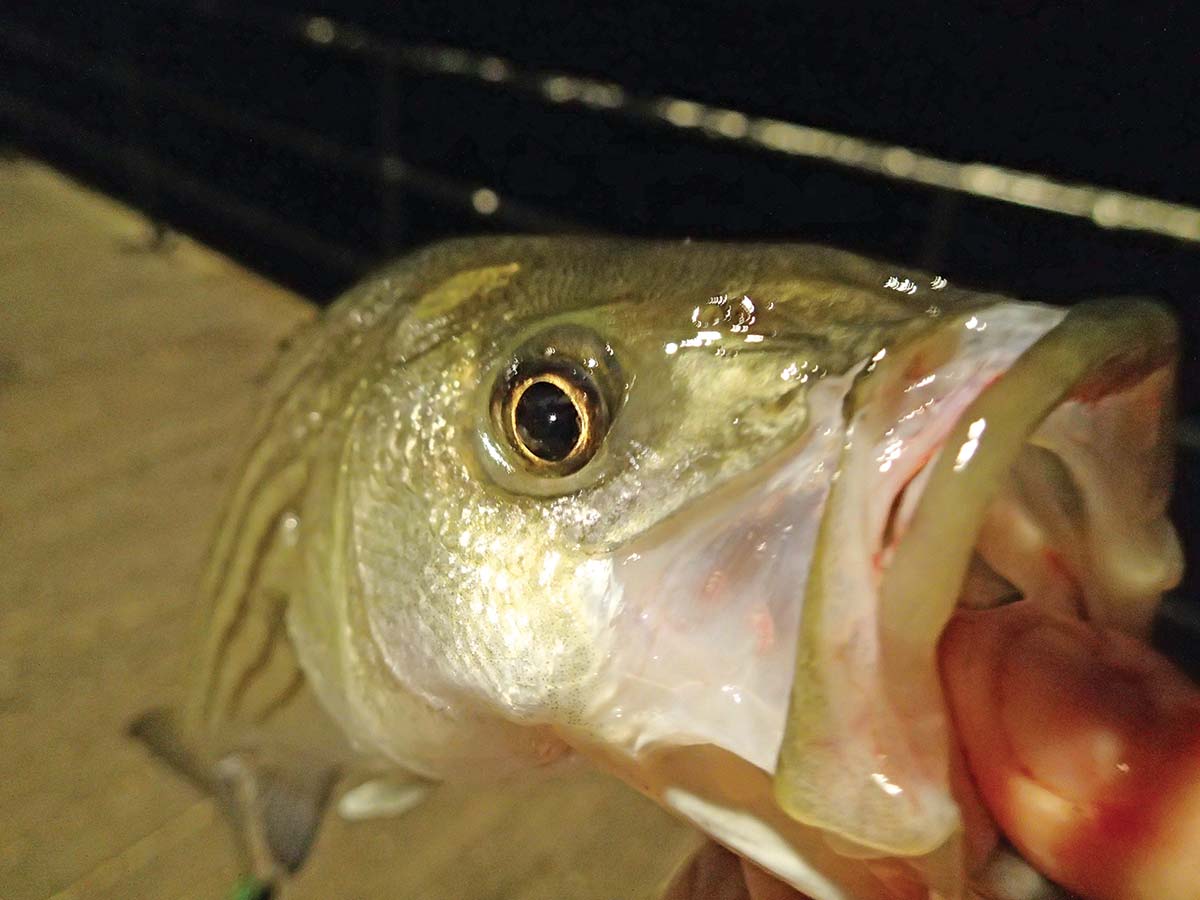
Combining Senses
We humans are used to having our five main senses, six if you count balance and equilibrium. Except for taste and smell, which have some overlap, we experience them distinctly. In fact, our brains possess separate processing lobes for vision, hearing, and touch. Now, imagine having two or three of those senses crammed together; for instance, seeing sound, or hearing colors. A psychedelic thought for sure, but in effect, that’s what striped bass do with certain senses.
Striped bass have overlapping tactile and auditory systems, meaning their touch and hearing are combined. Sure they have ear drums just behind and below their eyes, buried within their heads. However, there are no external openings, dissimilar to that of human ear canals. True, it is easier for sound waves to travel among the water medium as compared to that of air. But surely, this alone doesn’t compensate for accurate sound detection that would be provided by an external opening; that brings us back to the convergence of touch and hearing.
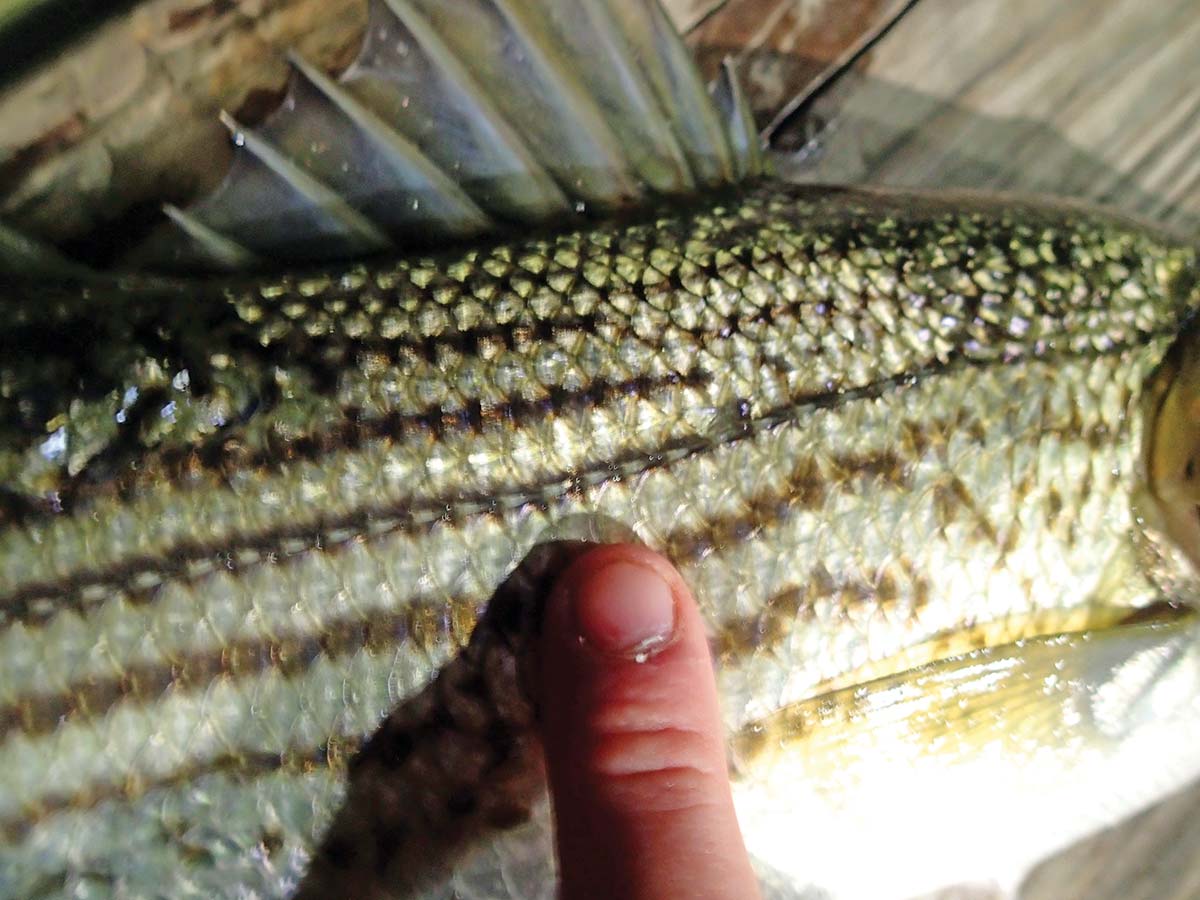
Striped bass possess a specific sensory organ that combines balance, touch, and hearing. That’s right, they hear touch and feel sounds! The lateral line is a network of mechanoreceptors (aka neuromasts) that run alongside the fish’s body. All fish, and some other aquatic vertebrates, possess a modified version of this system. The striped bass lateral line, however, is particularly in-tune. Evolutionary pressure from bass constantly navigating dark and/or murky waters likely led to this system’s refinement.
The lateral line is a system of pits and canals open to outside water. In these pits sit the neuromast sensory hair cells that detect micro-changes in water current near to the bass. Stimuli information is sent along the lateral line. Once integrated with the information input from the ears drums, otoliths, and other sensory cells, the signature of the external stimulus is determined as predator, prey, or neither, and in what proximity and orientation it is to the bass. In concert with the otoliths, the lateral line helps the bass determine its own orientation and position in the water, and at the rate and direction the water is flowing. It’s essentially a striper’s “super power” or super sense, and it’s needed to make up for the vision needed in most Striper Coast environments.
Getting A Visual
For the entirety of my 20-some odd years of surfcasting, I have witnessed heated debates over the best colors for plugging. Disputes about this occur in, and across groups of newbies, experienced, and even the very best striped bass anglers. Some discussions on the topic manifest in a shallow way, with dubious claims. More sophisticated debates involve the nuances in fishing context that may affect color choice. Pluggers, rest easy; what I’m about to say will not completely cease the fun bickering, as lure color does matter in certain contexts.
Like humans, stripers have two types of eye cells. Their cone cells sense and distinguish a similar range of light wavelengths as ours do; these are exclusively active in higher light situations. Their rod cells (like ours) sense intensity of light, and are exclusively active in very low to no light environments. You can test this on yourself by trying to see the red of an apple in a dark closet, and quickly realize you only perceive its dark outline. This means color does not matter for plugging at night in low light situations.
The exceptions, however, would be at night around well-lit areas, like a bright moon on a clear night, or along bridge/pier lights, where the bass, at least in part, use their cone cells to see color (Miller et. al, 1993). Colors around the green wavelength, specifically that of 528 nanometers, are what their cone cells are most sensitive to. Or, said another way, greenish colors are still registered by their cone cells at the least amount of light possible. This means a couple of things. For one, if you think there’s enough ambient light to make a difference, then try a variant of green. Secondly, anglers advocating chartreuse (a variant of green) for lure color have science backing their claim. So be prepared when debating them about a color you feel is superior!
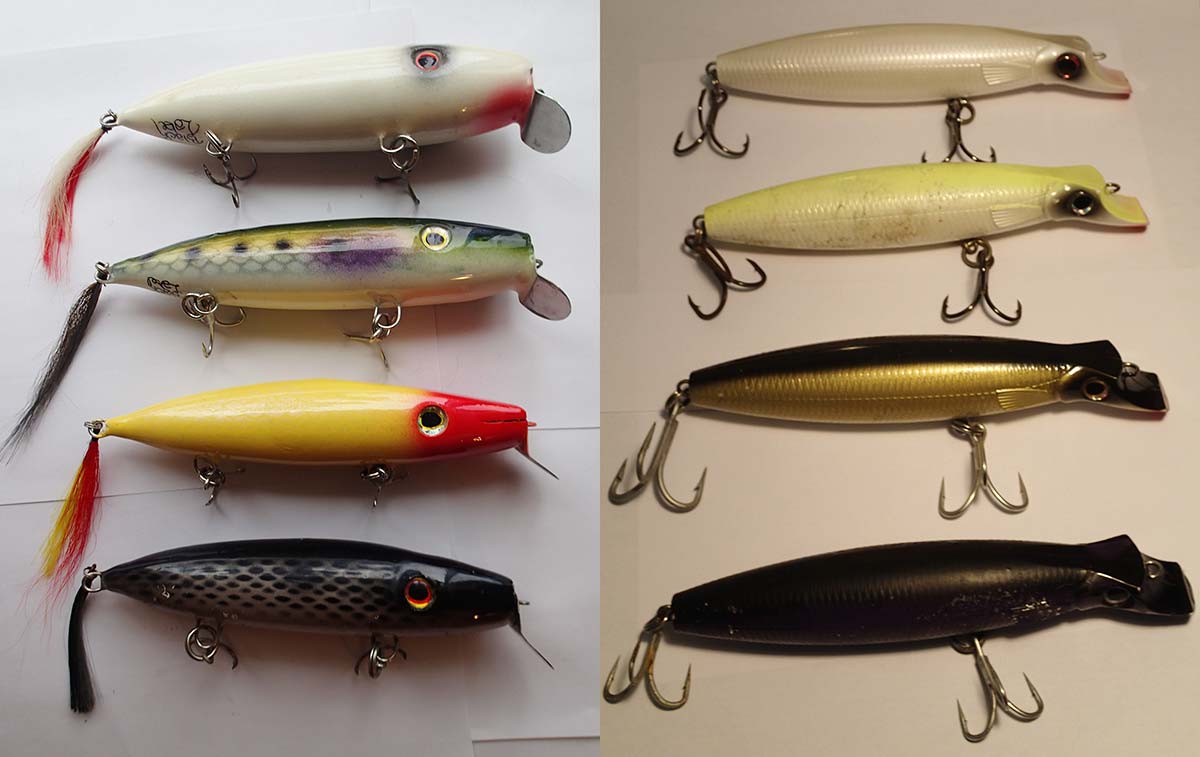
On a separate, but related topic, the eye lens of striped bass is unlike that of humans in that it is not adjustable. Humans use muscles to morph the shape of our lenses to visualize different distances with high resolution. Stripers cannot, which makes them perpetually near-sighted, and attenuates their visual acuity at a distance. The lack of color discernment in low light contexts is then exacerbated at further distances. Coming full circle about color, I’ll amend a prior statement; if you think there’s enough ambient light to make a difference, and are confident you can get a plug near enough to a fish where its near-sightedness will be exploited, try a variant of green first!
To get meticulously technical on fine-tuning color and its nuanced utility, look outside of biology and into physics for the wavelengths of these relevant colors. Understanding the variations in energy across the visible wavelengths can be used to appreciate which would most efficiently pierce through sediment in turbid water contexts. An analogy would be the non-fishing myth that human blood is blue. It is not; it only looks blue in veins because red wavelengths cannot penetrate out of the tissue, while higher-energy blue wavelengths pierce through the skin and are reflected back off the blood vessels to the eye. Extrapolate this to a turbid water context with stripers, where bluer colors more readily penetrate the suspended sediment to reach a striper’s eye.
Direct feeding-by-color studies for striped bass have yet to be done, but are in high need. Until then, recommence the bickering over plug properties in well-lit contexts. In fact, this author will make the first claim; it’s of my mere opinion that profile and action a far more a priority than plug color in almost all contexts.
What’s your opinion?




